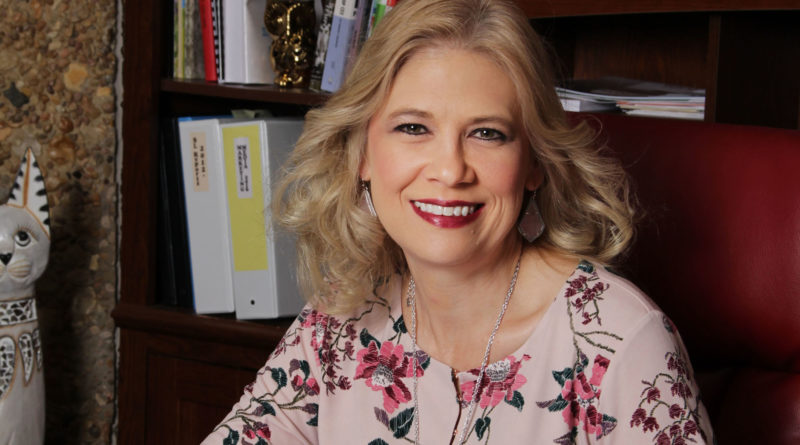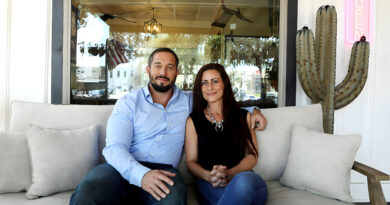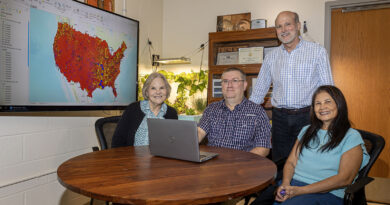Czech connection: Vestnik keeps Central Texas community close
By Emily Hilley-Sierzchula
Photo by Becky Stinehour
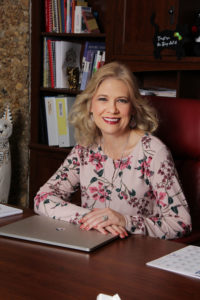
Melanie Zavodny is helping keep Czech culture alive in Texas through a colorful, vibrant weekly newspaper.
The historic weekly newspaper is the SPJST Vestnik (Slovanska Podporujici Jednota Statu Texas Vestnik), which in English means the Slavonic Benevolent Order of the State of Texas Bulletin. Since 1912 Vestnik has been the official publication of SPJST, a fraternal organization that started in 1897. The home office – or lodge – is in downtown Temple.
“Our members needed a place to share information, activities and have one place where everything could come together. It’s all good news in the Vestnik,” said Zavodny, SPJST Vestnik editor. “That’s part of what makes it good.”
Zavodny has been with SPJST for 24 years, including time as an assistant to the editor and youth program director, before being elected editor in 2004. She stays pretty busy. “No kids, just cats,” she said. Much of her job is juggling multiple projects, even beyond the publication of Vestnik, which can be challenging.
“We have so much participation. We’ve talked about cutting it back but how can we do that with all this material coming in … we’re an active organization,” she said. “We love getting the message out there to our membership. They have high expectations.”
Zavodny is third-generation Czech on both sides of her family. “We have plenty of stories passed down through the years, such as my grandmother coming over from the Czech Republic on a ship,” she said. “We keep up the traditions, having big family meals and gatherings. We’re a close family.”
Czech culture
Around the corner from Zavodny’s office is the Czech Heritage Museum, which is run by her cousin, Susan Chandler.
“Melanie and her sisters were the sweetest cousins, kind and calm; I loved going to their house to play,” Chandler said.
Chandler said she is not surprised by the success of the Vestnik. “Czechs have an affinity for the written word, drama, literature, journalism, so they established Czech-language weekly newspapers,” she said. “It’s still alive with the people of our Czech communities across the state.”
Chandler is among the thousands of readers of Vestnik, and she knows the paper gets around. “Whenever I send something to Melanie and she prints it, I get a ton of feedback. It’s definitely ‘social media.’”
As Texans proud of their Czech heritage, Zavodny and Chandler know their history. “There are so many, many things about the beautiful Czech culture,” Chandler said.
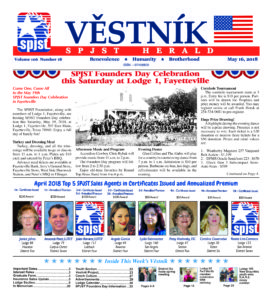 Known for its music, dance, beer and kolaches, Chandler said, “There is so much more to the culture than beer and kolaches; not everybody drinks beer.”
Known for its music, dance, beer and kolaches, Chandler said, “There is so much more to the culture than beer and kolaches; not everybody drinks beer.”
Cultural pride is one aspect that sets Czechs apart, Zavodny said. “We like to celebrate our heritage, which is why you see so many Czech festivals. We always find a reason to celebrate, to be happy. We love to party.”
The first wave of Czech immigration began before Texas became a state and was robust from around 1850 until the 1920s, when U.S. immigration laws changed. Part of the reason for the Czech people’s immigration was because of inheritance laws in the region under Austrian rule – only the oldest son could inherit property.
“Often the rest of the kids were just kind of stuck so they came over here. People would sell everything they had to come to America,” said Chandler who thinks there is a renewed wave of Czech immigration. “They come by the museum. We’re bridging across the ocean.”
After many years apart, Czech families in Texas are reconnecting with European kin. “European Czechs are always surprised by how many of us are here and how much we’ve held on to our culture,” Chandler said.
The newspaper is a way to keep a culture alive. Chandler said it’s partially because newly American Czechs formed communities and tried hard to assimilate.
“That’s why we’re losing the dialect. They were immersed in English and speaking Czech was discouraged.”
But the urge to understand family history through language runs deep, especially among a people with a history of being forced to speak other languages, like German.
The paper ran a series of Czech language lessons that hit a chord with people.
When Chandler went to visit her 103-year-old grandmother in a nursing home she discovered one of grandma’s secrets. In the bottom drawer of her bedside table was every one of those lessons, carefully dissected from the newspaper.
“Not that many people speak the Czech language anymore, and as time goes on it will be less and less; it’s unfortunate,” Zavodny said.
Vestnik
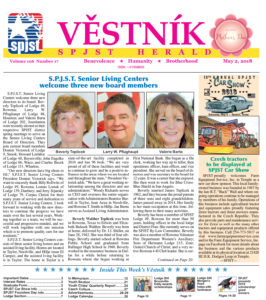 Vestnik was one of many Czech papers in the early 20th century. It was enlivened by color in 2005. Temple is the home lodge for SPJST, although there are more than 100 lodges statewide. Within each lodge is a youth club.
Vestnik was one of many Czech papers in the early 20th century. It was enlivened by color in 2005. Temple is the home lodge for SPJST, although there are more than 100 lodges statewide. Within each lodge is a youth club.
“The members of our lodges give a significant amount back to their communities,” Zavodny said.
Many of the stories and photos are sent from lodges to Zavodny. She said she enjoys covering larger events herself.
“It’s a lot of fun and I get to see a lot of the state and I’ve met many interesting people.”
Working with people is what she likes best about her job. “We’re a big family, so it’s great to get to know people better. When covering events, it’s not easy to leave. You have to walk around and say goodbye to everyone 15 times,” she said with a laugh.
“Vestnik incorporates plenty of heritage and cultural-related information,” Zavodny said. “It helps people relate and be proud of their heritage.”

